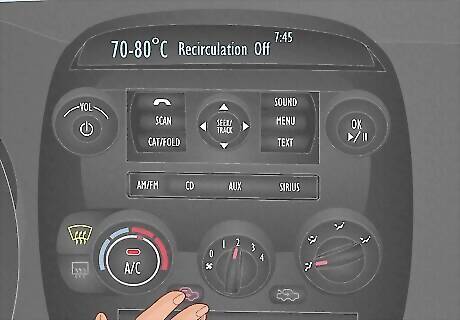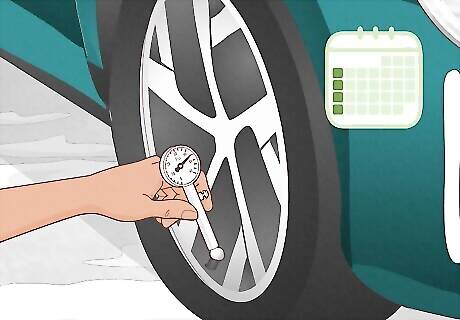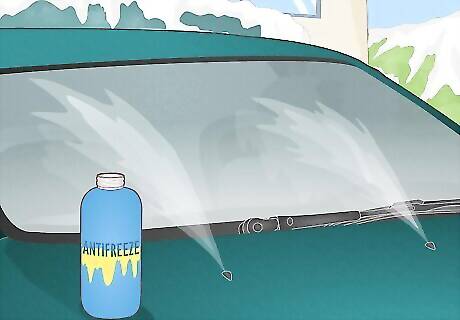
views
- Turn on your engine and heater to start melting the ice from the inside.
- Spray a mixture of 2⁄3 cup (160 ml) isopropyl or rubbing alcohol with 2⁄3 cup (160 ml) water onto your windshield to break down the ice.
- Scrape the remaining frost with an ice scraper or heavy windshield wipers to fully defrost your windshield.
How to Defrost the Outside of a Windshield

Turn on your heater and push the defrost/defog button. Set your heater to the highest possible temperature. If you have one defrost/defog button for your front windshield and another for the rear windshield, activate both. The defroster or defogger button usually looks like a window with three curved arrows pointing upward. The front windshield defroster will look like a curved window, while the rear window button will look like a rectangular window. Increasing the heat in the car will absorb the moisture in your vehicle and start to melt the ice on the outside of your windshield.

Turn on your air conditioning and air circulation. Turning on your A/C helps cool the air in the car and remove moisture faster. By also activating air circulation, cold winter air will enter the car and dry out the moist air trapped inside.

Crack your windows. Slightly opening the windows helps the dry winter air enter your car, reducing condensation and moisture.

De-ice your windshield with an alcohol solution. The quickest way to de-ice your windshield after defrosting is to mix ⁄3 cup (160 ml) isopropyl or rubbing alcohol with ⁄3 cup (160 ml) water. Pour the mixture into a spray bottle and gently spray the solution on your windshield. This spray bottle mixture will not freeze, so you can leave it in the car for the next time you need it.

Scrape off the melted ice. Let the alcohol solution sit for a few seconds. Then, use a windshield scraper, ice scraper, or winter windshield wipers to remove the ice and frost. Start at the top of the windshield and work your way down.
How to Defog a Windshield

Determine if the fog is on the inside or outside of your window. If you’re inside the car, touch the inside of the windshield with your finger and observe whether the fog wipes away. If it doesn’t, the fog is on the outside of the windshield. According to professional mechanic Ed Beery, fog inside the windshield means the outside temperature is below or at freezing. In this scenario, Beery instructs not to open the car windows or doors, which “can cause the fog on the inside of the windows to frost over [and] make matters much worse.”

To defog the inside of a windshield, press the defog button. Set the defog button, which is the same as a defrost button, to its warmest setting with the fan on high. Turn off the recirculation button so cooler air can enter the vehicle from outside. Turn on your rear window defogger if you have one. Automotive specialist Ed Beery recommends turning on the AC initially, but you should turn the AC off once the fog begins to lift.” Then, continues Beery, “wipe the inside of the windshield and windows with a warm, dry towel.” Finally, roll down your windows to balance out the inside and outside temperatures. Revert to your preferred heat and fan settings once your windshield is fully defogged.

To defog the outside of a windshield, click the defroster button. Set the defroster (or defogger) and fan to their highest temperature and setting. Turn off the recirculation button to “equalize the inside and outside temperature,” says expert mechanic Ed Beery. Turn on your rear window defroster if you have one. As a final step, Berry recommends that you “turn your windshield wiper on and set it to an appropriate cycle to wipe the windshield as additional condensation forms.”

To keep your windshield defogged, turn off the recirculation button. Select Airflow Distribution to the windshield and floor. Turn the fan to a medium setting and keep the heat between 70–80 °C (158–176 °F). If your car has a defroster setting, you can simply turn that on to blow warm air onto your windshield. Alternatively, buy an anti-fog solution and follow package directions to keep your windshield clear. Other tricks to remove fog from a window include putting a thin layer of shaving cream on the inside of your windshield and wiping it off with a clean cloth. This hack should keep your windshield fog-free for a few weeks. Another quick way to defog your windshield is by filling a sock with cat litter and rubbing the sock over the windshield when it starts to fog up.
Tips to Take Care of Your Car in the Winter

Keep your gas tank at least half full. Condensation can occur in your gas tank when it’s cold outside, leading to water mixing with your gas—which can lead to corrosion or make your engine stall out. By keeping your gas tank full, there won’t be enough air for condensation to form. This step is especially important if your car runs on diesel.

Check your tire pressure once a week. Remove the cap from your tire’s air valve and press a tire gauge against the open valve for a few seconds. You may hear a hiss of air, which is normal when checking your tire’s air pressure. Read the air pressure gauge, which will either digitally show a number or have a dial pointing to the pressure level. Compare this number to the recommended tire pressure for your vehicle. Replace the tire’s air valve cap, and bring your car to a service station to inflate the tires if needed. Keeping your tires properly inflated is essential in the winter because tires lose air in colder temperatures.

Coat your exterior paint with polymer wax. Apply a coat of polymer wax to your vehicle when the weather starts to dip. Give your car a rinse to remove the build-up at the end of the winter season. The wax creates a barrier against harsh winter elements like road salt, snow, sleet, and grime.

Test your battery. To check your battery yourself, remove the plastic caps on the top and check the fluid level. Add distilled water if the fluid is low. If you have a non-conventional, maintenance-free battery, check if the window at the top of the battery shows a full charge. If the above steps don’t apply to your vehicle, check your owner’s manual for instructions on checking the battery. You can also have the battery tested by a professional at a service station, auto parts store, or repair shop. Test your battery at least twice a year. Check your battery in the late fall, right before winter, and again in the late spring.

Flush and fill your coolant supply. Flush your radiator by filling it with distilled water, running the engine, then draining the water. Add fresh coolant up to the MAX or FILL line. Keep your coolant mixture in a 50/50 ratio of antifreeze and water. If you live in an extremely cold environment where temperatures typically drop far below zero, you can use a 60/40 or 70/30 ratio.

Equip your car with winter tires. Worn-out tires can easily cause you to spin out when faced with heavy ice and snow. Ask your mechanic for a set of all-season tires and replace all four tires at once. If you live somewhere that it snows year round, buy special winter tires that are specially designed to grip the snow and ice.

Add antifreeze to your windshield washer fluid. Antifreeze mixes with water so the fluid doesn’t freeze, says auto body technician Chad Zani. However, Zani advises to use this trick with caution, as you’ll have to regularly rinse your car to prevent the antifreeze from damaging the paint.




















Comments
0 comment